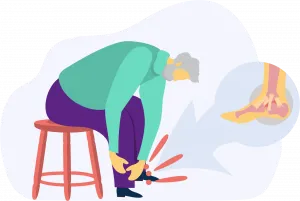General Health | 4 min read
Difference Between Sprain and Strain: Here's What You Need to Know
Medically reviewed by
Table of Content
Synopsis
A sprain is usually an injury to a ligament, which connects bone to bone, often caused by a sudden twist or wrenching movement. A strain is recognized as an injury to a muscle or tendon, which connects the muscle to the bone, typically caused by overuse or repetitive movement. Both can cause pain, swelling, and limited mobility.
Key Takeaways
- It is difficult to diagnose for most of us after an injury whether it is a sprain or a strain
- Sprains and strains both are mainly caused when the joint is put under physical stress
- A sprained ligament is more susceptible to get sprained again in future if it is not strengthened
We have heard both these terms; Sprain and Strain quite often and may have used them interchangeably. But it is difficult to diagnose for most of us after an injury whether it is a sprain or a strain. This article shall help you not just differentiate between the two but also how to do the first line of treatment and prevent the same.
Difference Between Sprain and Strain
A sprain at a joint is an injury to a ligament which is a tissue that connects two or more bones. The sprain causes pain, swelling, bruising, and restrictions on using the joint.
A strain is an injury to a muscle or tendon which are the fibrous cords of tissue that connect muscle to the bone. Strain symptoms include pain, muscle spasms, swelling, cramping, and trouble in moving the joint.
Cause
Sprains and strains both are mainly caused when the joint is put under physical stress with an activity that the body is not accustomed to. It can be repetitive actions of motion or by a single overuse injury.
Examination
When one is injured, the healthcare professional first performs the physical examination of the part of the body that is injured. The swelling and tenderness can help determine the extent of the injury. It is important to rule out any broken bones or fractures. Your doctor may suggest X-rays for the same. The pulses and sensation may also be checked to certain that there is no associated nerve or artery damage. CT scan or MRI can help detect damage to the bones, muscles, tendons, ligaments, cartilage, and other structures.
Sprains and Strains are graded according to the severity of the damage:
- Grade 1 usually causes stretching of a few muscle fibers in strain or ligament fibers in a sprain.
- Grade 2 has more significant damage, causing a partial tear of the muscle/ligament.
- Grade 3 strain is a complete rupture of the muscle/ligament.
Treatment
In case of a mild sprain or a strain, the first line of treatment can start from the point of the injury itself. This can help prevent the increase in inflammation. The technique is called R.I.C.E; that is Rest, Ice, Compression and Ice.
- Rest: Movement of the affected joint should be restricted, to give the fibres time to heal.
- Ice: Icing the affected area immediately can help reduce inflammation and swelling. It should not be applied directly to the skin, it should be wrapped in a thin towel or cloth and applied for 15-20 minutes every three to four hours for the first few days of the injury.
- Compression: To reduce the swelling, compression with the help of an elastic bandage is required. Care should be taken that it should not be too tight else it can hinder the circulation. The bandage should be loosened if there is an increase in the pain or if the area becomes numb.
- Elevation: Elevating the affected joint above the level of the heart helps gravity to reduce the swelling.
Your doctor may suggest that you immobilize the area with a brace or splint in severe cases. A physiotherapist can help reduce pain, increase the stability and strength of the injured joint or limb. A sprained ligament is more susceptible to get sprained again in future if it is not strengthened. A physiotherapist helps gain that strength with exercises. More severe sprains or strains can require further interventions and even surgery.

Prevention
Injuries happen accidentally and there is not much we can do about it. But there are few tips which can prevent the occurrence of sprains or strains.
- Stretching: Warm up with stretches is important before playing sports or working out at the gym. This helps to prepare your muscles and prevents injury. It is important to cool down the muscles post-workout as well.
- Regular Exercising: Training the body well to keep the joints flexible and strong helps to prevent injury.
- Be cautious: It is always better to be cautious than to be sorry later. Take care in the rains, snow or slippery roads by wearing proper shoes.
- Listen to your body: Repetitive stress to the muscles leads to injury. Hence take breaks whenever it feels that the muscles are put under strain.
- Proper posture: Learn proper posture while working out in the gym with a professional trainer to avoid injuries.
But self diagnosis can be tricky, which is why you should always consult a medical specialist before making any conclusions. Find one from the comfort of your home on Bajaj Finserv Health. View doctors’ years of experience, consulting hours, fees and more before booking an e-consult or in-person appointment. Apart from facilitating appointment booking, Bajaj Finserv Health also offers health plans for your family, medicine reminders, healthcare information and discounts from select hospitals and clinics.
References
Disclaimer
Please note that this article is solely meant for informational purposes and Bajaj Finserv Health Limited (“BFHL”) does not shoulder any responsibility of the views/advice/information expressed/given by the writer/reviewer/originator. This article should not be considered as a substitute for any medical advice, diagnosis or treatment. Always consult with your trusted physician/qualified healthcare professional to evaluate your medical condition. The above article has been reviewed by a qualified doctor and BFHL is not responsible for any damages for any information or services provided by any third party.





